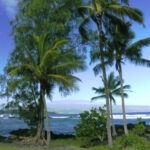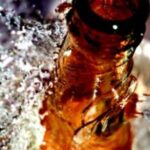Kona coffee has the reputation of being one of the finest coffees in the world. Its smooth, yet rich and flavorful quality, justifies its price tag. People who come to Hawaii, seek out the coffee to bring home as gifts and a “must have” for their pantries.
Kona coffee passes through many hands, and creates a unique economy of its own. For instance, the first stage of coffee growing is planting trees. The trees must have the perfect temperature, not too much sun and not too much rain. This ideal temperature is found on the slopes of Mauna Loa, called the “mauka” country of Kona. Here, the mornings are sunny and warm, and the afternoon clouds roll in to cool the plants down.
Coffee trees are resilient, and can survive the dry season in the winter months. The coffee trees will droop, turn yellow and brown, and look like they are dying, but such is not the case. When the rain comes, these trees bounce back into vibrant,, shiny, green-leaved, beauties. What is hard on the trees, is too much rain. Endless rain, created by storms following one another, during the winter months, create what is called a “bumper crop.” This crop happens when the weather causes the trees to go into full bloom at once. Instead of gradual coffee ripening, which is good for the coffee farmers, the bumper crop gives off a short harvest, then ends. Such was the case of the coffee season in 2007. The loss of crops was a disappointment to farmers.
After coffee trees are planted, they must be fertilized. They require consistent periods of fertilization throughout the year. Even though the volcanic soil is rich with minerals, the coffee trees require more nutrition. During late winter and early spring, the coffee trees burst into white flowers. The trees look snow-covered and smell sweet. This is a delicate time for coffee trees, and like pregnancy, the trees need rest and quiet time. This is not the time to prune them or yank on them.
When the flowers turn into buds, it is time to fertilize them again, and pull off saplings from the trees. Saplings are unwanted branches that take away the trees’ nutrition. After pulling off unwanted saplings, it is time to pull up unwanted weeds. Some farmers use poison to eradicate the weeds, but the organic farmers do not. Organic coffee is premium Kona coffee, and brings a well deserved compensation to the farmers. Organic coffee is soft and smooth in taste.
Harvest time arrives in late summer and early fall. This is an exciting time, when the buds have turned into bright red berries. Farmers put coffee baskets around their waists, gently pulling off the “cherry,” making sure to keep the stems of the coffee berries intact on the trees. These stems will guarantee the formation of new buds in the following year.
After the “cherry” beans are gathered in the coffee baskets, they must be soaked, and the outer skins removed. There are special machines called “pulpers” to remove the skins. Now the beans are no longer plump red berries, but are a skinnier, greener, version of the cherry. The farmer rinses these “green beans” and puts them out on drying decks in the sun. It takes several weeks to dry the beans. The farmer rakes the beans, making sure the sun is ingested by the entire beans. If rains come, the farmer must pull a roof over these beans. If the beans get wet, they will become moldy and ruined.
When the beans are dried, they need yet another skin removed. This skin is light in texture, looking almost like thin paper. After this skin is removed, it is called “parchment,” and is now very valuable in the market place. The farmer can choose to sell the parchment, or go one step further, and roast the coffee. The roasting is done at a high temperature, and must be done for precisely the right amount of time. After roasting, the coffee is ready for packaging and commercial sales.
Coffee harvesting runs from August through January, depending on the elevation of the farms. Kona celebrates harvesting time with the “Kona Coffee Festival.” This festival starts in November, and runs through the entire month. There are festivities such as the coffee picking contest, the labeling contest, the Miss Coffee pageant, the lantern parade, and finally, the most exciting for farmers, the “coffee cupping contest.” Here, the judges pick the best coffees of the season, and the lucky farmers get awards. The entire festival is capped off with dinner and awards. It is a happy time in Kona.



